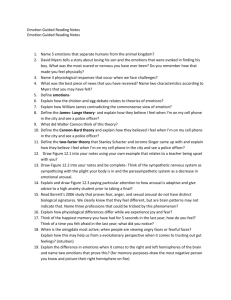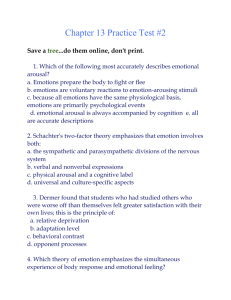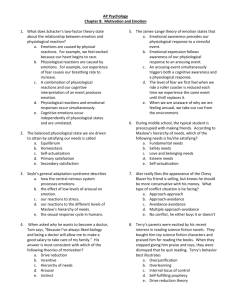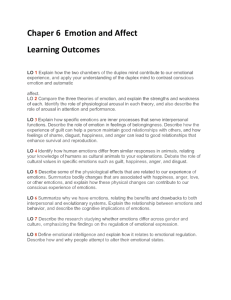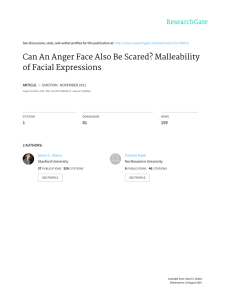Emot Practice Test1
advertisement
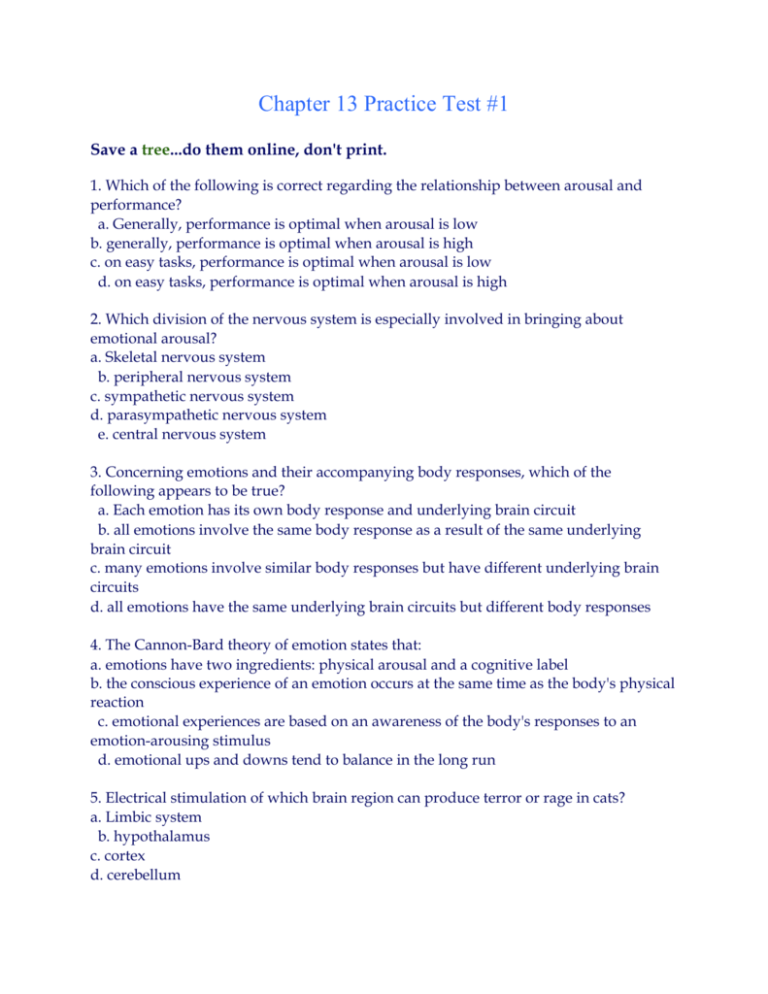
Chapter 13 Practice Test #1 Save a tree...do them online, don't print. 1. Which of the following is correct regarding the relationship between arousal and performance? a. Generally, performance is optimal when arousal is low b. generally, performance is optimal when arousal is high c. on easy tasks, performance is optimal when arousal is low d. on easy tasks, performance is optimal when arousal is high 2. Which division of the nervous system is especially involved in bringing about emotional arousal? a. Skeletal nervous system b. peripheral nervous system c. sympathetic nervous system d. parasympathetic nervous system e. central nervous system 3. Concerning emotions and their accompanying body responses, which of the following appears to be true? a. Each emotion has its own body response and underlying brain circuit b. all emotions involve the same body response as a result of the same underlying brain circuit c. many emotions involve similar body responses but have different underlying brain circuits d. all emotions have the same underlying brain circuits but different body responses 4. The Cannon-Bard theory of emotion states that: a. emotions have two ingredients: physical arousal and a cognitive label b. the conscious experience of an emotion occurs at the same time as the body's physical reaction c. emotional experiences are based on an awareness of the body's responses to an emotion-arousing stimulus d. emotional ups and downs tend to balance in the long run 5. Electrical stimulation of which brain region can produce terror or rage in cats? a. Limbic system b. hypothalamus c. cortex d. cerebellum 6. The body's response to danger is triggered by the release of ________ by the _______ glands a. acetylcholine; adrenal b. epinephrine and norepinephrine; adrenal c. acetylcholine; pituitary d. epinephrine and norepinephrine; pituitary 7. Which of the following was not raised as a criticism of the James-Lange theory of emotion? a. The body's responses are too similar to trigger the various emotions b. emotional reactions occur before the body's responses can take place c. the cognitive activity of the cortex plays a role in the emotions we experience d. people with spinal cord injuries at the neck typically experience less emotion 8. (Thinking critically) Current estimates are that the polygraph is inaccurate approximately _______ of the time a. three-fourths b. one-half c. one-third d.one-fourth e.one-tenth 9. In the Schachter-Singer experiment, which subjects reported feeling an emotional change in the presence of the experimenter's highly emotional confederate? a. Those receiving epinephrine and expecting to feel physical arousal b. those receiving a placebo and expecting to feel physical arousal c. those receiving epinephrine but not expecting to feel physical arousal d. those receiving a placebo and not expecting to feel physical arousal 10. Which of the following is true? a. People with more education tend to be happier b. whites tend to be happier than latinos c. women tend to be happier than men d. people with children tend to be happier e. people who are socially outgoing or who exercise regularly tend to be happier 11. Catharsis will be most effective in reducing anger toward another person if: a. you wait until you are no longer angry before confronting the person b. the target of your anger is someone you feel has power over you c. your anger is directed specifically toward the person who angered you d. the other person is able to retaliate by also expressing anger 12. Emotions are: a. physiological reactions b. behavioral expressions c. conscious feelings d. all of the above 13. Law enforcement officials sometimes use a lie detector to assess a suspect's responses to details of the crime believed to be known only to the perpetrator. This is known as the: a. inductive approach b. deductive approach c. guilty knowledge test d. screening examination e. prevarication probe 14. Research on nonverbal communication has revealed that: a. it is easy to hide your emotions by controlling your facial expressions b. facial expressions tend to be the same all over the world, while gestures vary from culture to culture c. most authentic expressions last between 7 and 10 seconds d. most gestures have universal meanings; facial expressions vary from culture to culture 15. In laboratory experiments, facial expressions of fear and anger have been found to result in: a. an increase in skin temperature b. increases in skin temperature and heart rate c. strong feelings of fear and anger d. subtly different body reactions e. all of the above 16. Research suggests that people generally experience the greatest well-being when they strive for: a. wealth b. modest income increases from year to year c. slightly higher status than their friends, neighbors, and co-workers d. intimacy and personal growth 17. Research indicates that a person is most likely to be helpful to others if he or she: a. is feeling guilty about something b. is happy c. recently received help from another person d. recently offered help to another person 18. Darwin believed that: a. the expression of emotions helped our ancestors to survive b. all humans express basic emotions using similar facial expressions c. human facial expressions of emotion retain elements of animals' emotional displays d. all of the above are true 19. Research supporting the opponent-process theory of emotion suggests that: a. the price of pleasure is pain b. with repetition a task that arouses fear will become more tolerable c. suffering can pay emotional dividends d. all of the above are true 20. Evidence that changes in facial expression can directly affect people's feeling and body states has convinced Robert Zajonc that: a. the heart is always subject to the mind b. emotional reactions involve deliberate rational thinking c. cognition is not necessary for emotion d. the interpretation of facial expressions is a learned skill Answers 1. D 2. C 3. C 4. B 5. A 6. B 7. D 8. C 9. C 10. E 11. C 12. D 13. C 14. B 15. D 16. D 17. B 18. D 19. D 20. C
